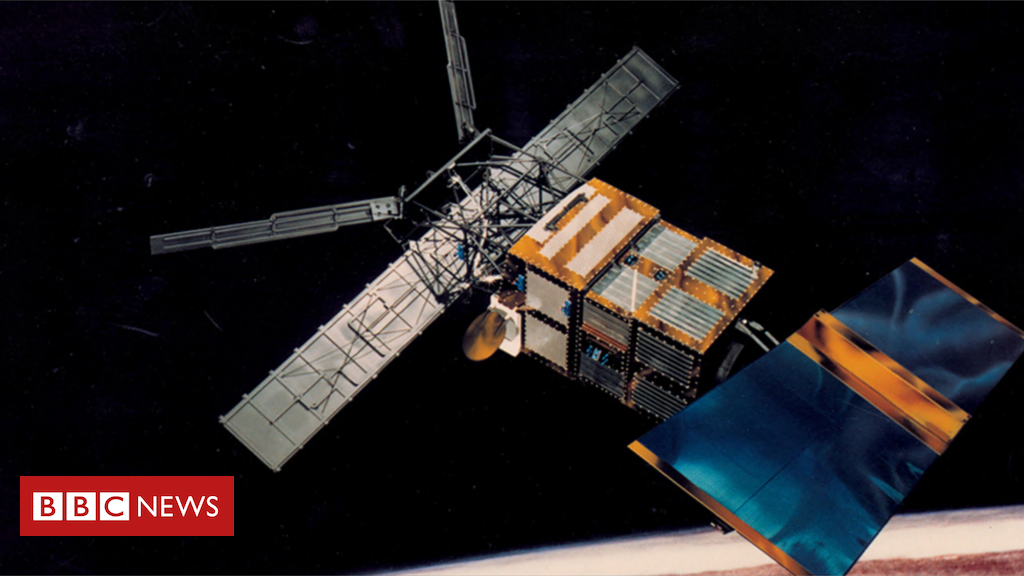credit, European Space Agency
The European Earth Remote Sensing Satellite weighed about 2.5 tons when launched
- author, Jonathan Amos
- scroll, Science correspondent, BBC News
- Twitter,
A pioneering European satellite is expected to fall to Earth in the coming hours.
ERS-2 was a cutting-edge observing platform when it was launched in 1995, and it helped shape the techniques that are now routinely used to monitor the planet.
The device's activity has gradually decreased since it stopped working in 2011.
Now, the device will undergo a violent and uncontrolled “dive” in the atmosphere during Wednesday (2/21).
The European Space Agency (ESA) says most of the two-ton satellite will burn up and collapse during landing.
It is possible that some of the larger, more powerful pieces can withstand the intense heat generated during a high-speed fall, but the chances of these fragments reaching populated areas and causing damage are minimal, experts guarantee.
These pieces of satellite could land almost anywhere in the world, but since most of the Earth's surface is covered by ocean, any debris that survives the friction would likely be lost to the sea.
“It is worth noting that none of the elements that can enter the atmosphere (and reach the surface) are radioactive or toxic,” said scientist Mirko Albani, from the European Space Agency's Earth Observation Division.

credit, European Space Agency
Sea surface temperature: Current climate monitoring owes a “debt” to the program that launched the ERS satellites
The European Space Agency launched two nearly identical Earth remote sensing satellites — known by the acronym ERS — in the 1990s.
They both performed the most advanced planetary observations of the time and carried a suite of instruments for monitoring changes occurring on land, in the oceans, and in the air.
The devices monitored floods, measured surface temperatures of continents and oceans, tracked the movement of ice fields, and monitored ground deformation during earthquakes.
ERS-2, specifically, has provided a new possibility for assessing the Earth's protective ozone layer.
The pair of satellites have been described as “the forefathers of Earth observation in Europe.”
“In terms of technology, it is possible to draw a direct line from ERS to the European Copernicus/Sentinel satellites that monitor the planet today,” says Ralph Cordy, director of Earth observation sector development at Airbus.
“ERS was where it all started,” he added.
ERS-2 is the first pair to return home. It was originally 780 kilometers above the ground, and engineers used final fuel reserves in 2011 to lower its altitude to 570 kilometers.
It was expected that the upper layer of the atmosphere would drag the spacecraft to destruction within about 15 years.
According to scientists, this is exactly what should happen on Wednesday, after 13 years of declining heights.

credit, Airbus
The German company Dornier (now part of Airbus) led the assembly of the ERS satellites
The satellite is expected to collapse between the end of the morning and the afternoon, Brasilia time, on Wednesday (2/21).
It is difficult to determine precisely when and where it will fall. This varies with the density of the upper atmosphere, which in turn is affected by solar activity.
What can be said with certainty is that the return will occur between 82 degrees north and south, as this was the range of the satellite's orbit around the Earth.
Space debris experts at the European Space Agency estimate that small material from ERS-2 will resist friction and reach the Earth's surface.

credit, Hugh
HEO, an Australian tracking company, is tracking the descent of ERS-2
Fragments that can reach the surface include interior panels and some metal parts, such as fuel tanks.
The most likely element to pass through the atmosphere in some way is the radar system's antenna, which was built in the United Kingdom.
The antenna has a carbon fiber structure capable of withstanding high temperatures.
When ERS-2 was launched, space debris mitigation guidelines were more flexible. It was acceptable to bring a spacecraft home 25 years after the end of operations.
ESA's new Zero Waste Charter recommends that the grace period for disposal of such items should not exceed five years. Future satellites will be launched with the necessary fuel and the ability to leave orbit by propulsion in a short period of time.
The reason is clear: with too many satellites in orbit, the odds of collision have increased dramatically.
For example, ERS-1 suddenly failed before engineers could lower its altitude.
This device is still more than 700 kilometers above the ground. At that point, it could take 100 years for it to fall naturally.

credit, European Space Agency
Hayward Fault in California: ERS was a pioneer in mapping rock movement
The US company SpaceX, which operates most of the satellites currently in orbit – there are more than 5,400 – recently announced that it would shoot down 100 of them after discovering a defect that “may increase the likelihood of failure in the future”.
The company wants to remove the objects before any problems make the job more difficult.
Last week, the Safer World Foundation, an advocacy group for the sustainable use of space, and LeoLabs, a US company that tracks space debris, issued an urgent statement about the need to remove devices in orbit that are no longer working.
“The accumulation of abandoned objects in low-Earth orbit remains the same, with 28% of large, long-lived abandoned objects left in orbit since the turn of the century,” the text says.
“These clusters represent the largest debris-generating potential of the thousands of recently deployed satellites that power the global space economy,” the statement concludes.

“Incurable thinker. Food aficionado. Subtly charming alcohol scholar. Pop culture advocate.”






More Stories
NASA Releases Selfie of Perseverance Rover Working on Mars
NVIDIA driver includes hidden Final Fantasy XVI profile
PlayStation Plus Extra and Premium saw a significant drop in players in July